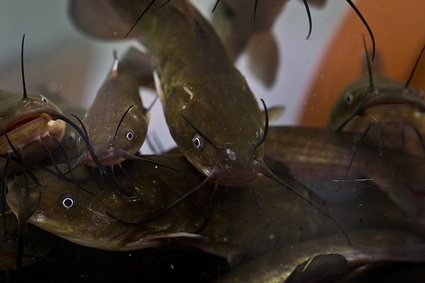 Kris Verdonck, EXOTE, 2011. Produced for the exhibition Kris Verdonck – EXHIBITION at #1. Photo: Kristof Vrancken / Z33
Kris Verdonck, EXOTE, 2011. Produced for the exhibition Kris Verdonck – EXHIBITION at #1. Photo: Kristof Vrancken / Z33
The European Union defines “Invasive Alien Species” as those that thrive outside their natural distribution area and threaten biological diversity. One of the most dramatic examples of it is the one of the descendants of an original cargo of 24 rabbits that were shipped from Europe to Australia in 1859 for the pleasure of a man missing the joys of rabbit hunting. Within ten years of their introduction, they had become so prevalent that two million of them could be shot or trapped each year without any effect on the population being noticed. European rabbits have no natural predators in Australia and their impact on the ecology is devastating. The hunting prey quickly became nothing more than pest that has to be eradicated by all means. The poor creatures are vilified to the point that the Easter bunny has been replaced by the Easter Bilby.
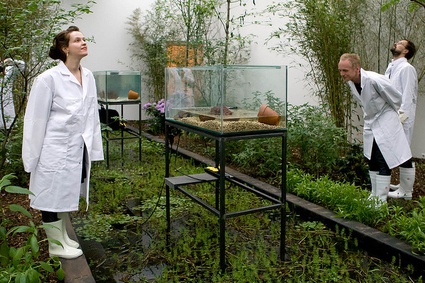 Kris Verdonck, EXOTE, 2011. Produced for the exhibition Kris Verdonck – EXHIBITION at #1. Photo: Kristof Vrancken / Z33
Kris Verdonck, EXOTE, 2011. Produced for the exhibition Kris Verdonck – EXHIBITION at #1. Photo: Kristof Vrancken / Z33
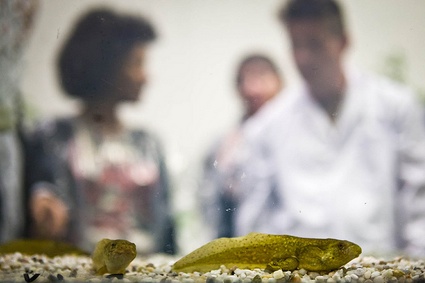 Kris Verdonck, EXOTE, 2011. Produced for the exhibition Kris Verdonck – EXHIBITION at #1. Photo: Kristof Vrancken / Z33
Kris Verdonck, EXOTE, 2011. Produced for the exhibition Kris Verdonck – EXHIBITION at #1. Photo: Kristof Vrancken / Z33
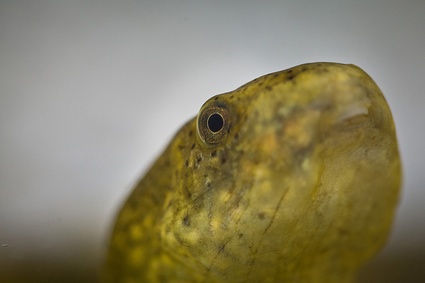 Kris Verdonck, EXOTE, 2011. Produced for the exhibition Kris Verdonck – EXHIBITION at #1. Photo: Kristof Vrancken / Z33
Kris Verdonck, EXOTE, 2011. Produced for the exhibition Kris Verdonck – EXHIBITION at #1. Photo: Kristof Vrancken / Z33
Theatre maker and visual artist Kris Verdonck selected terrestrial plants, crustraceans, insects, fish, amphibians, birds and other organisms in the list of IAS that live in Belgium. Then he put them all together in one big luminous garden on the first floor of the contemporary art space Z33 in Hasselt, Belgium.
The result is an artificial jungle of bamboo, parrots, bullfrogs, Japanese knot weeds, parrots and little trees carrying blue berries. Before entering, however, you are invited to wear white rubber boots, a pair of gloves, and a lab coat. As if you were about to enter a contaminated space? Or maybe it’s the space that shouldn’t be contaminated by you? After all, men are ultimately, the ones responsible for any ecological damage caused by non native species. They are the ones who introduced them into the new habitat, intentionally or by accident (when exiting Z33 with seeds that would further invade the local fauna for example.) What is sure is that the pristine antechamber in all its whiteness and sanitariness offers a striking contrast to the garden, all messy and multicolored. No one could have orchestrated the effect better than a theater maker like Verdonck.
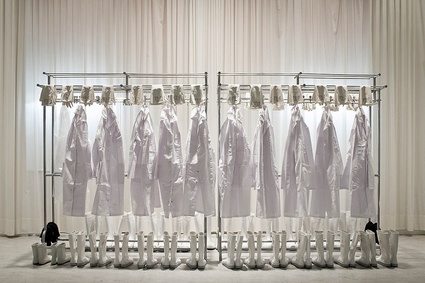 Kris Verdonck, EXOTE, 2011. Produced for the exhibition Kris Verdonck – EXHIBITION at #1. Photo: Kristof Vrancken / Z33
Kris Verdonck, EXOTE, 2011. Produced for the exhibition Kris Verdonck – EXHIBITION at #1. Photo: Kristof Vrancken / Z33
Once you’re inside, it’s easy to forget that these are ‘invasive alien species.’ Take the green parakeets. In 1975, they were only roughly 50 of them when the manager of an amusement park decided to release them in the wild. Thousands of them can now be found in Brussels parks and suburbs. They are seen as a threat to native species because they have the potential to outcompete them for nest sites as they begin nesting several weeks before most species. American bullfrogs –carriers of infectious disease and predators of native of molluscs, fishes and young water birds– are seen as such a threat to biological diversity that their eradication was strongly recommended by the Council of Europe.
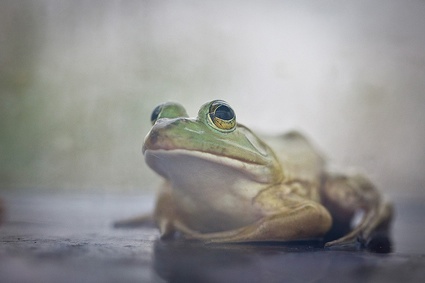 Kris Verdonck, EXOTE, 2011. Produced for the exhibition Kris Verdonck – EXHIBITION at #1. Photo: Kristof Vrancken / Z33
Kris Verdonck, EXOTE, 2011. Produced for the exhibition Kris Verdonck – EXHIBITION at #1. Photo: Kristof Vrancken / Z33
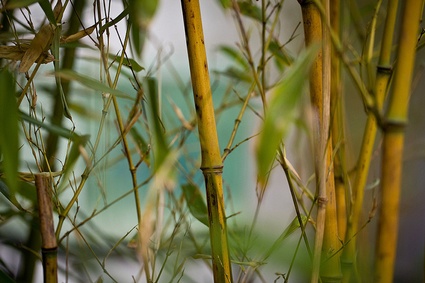 Kris Verdonck, EXOTE, 2011. Produced for the exhibition Kris Verdonck – EXHIBITION at #1. Photo: Kristof Vrancken / Z33
Kris Verdonck, EXOTE, 2011. Produced for the exhibition Kris Verdonck – EXHIBITION at #1. Photo: Kristof Vrancken / Z33
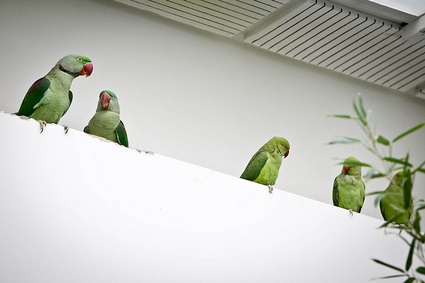 Kris Verdonck, EXOTE, 2011. Produced for the exhibition Kris Verdonck – EXHIBITION at #1. Photo: Kristof Vrancken / Z33
Kris Verdonck, EXOTE, 2011. Produced for the exhibition Kris Verdonck – EXHIBITION at #1. Photo: Kristof Vrancken / Z33
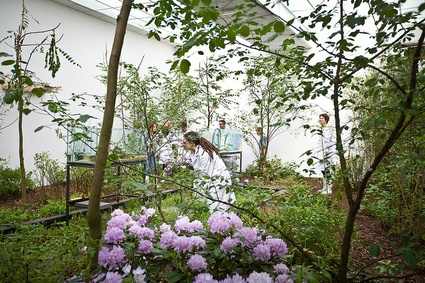 Kris Verdonck, EXOTE, 2011. Produced for the exhibition Kris Verdonck – EXHIBITION at #1. Photo: Kristof Vrancken / Z33
Kris Verdonck, EXOTE, 2011. Produced for the exhibition Kris Verdonck – EXHIBITION at #1. Photo: Kristof Vrancken / Z33
Verdonck’s garden opened in May and looked like a little piece of Eden. All lush flowers, green parrots, colourful plants, cheerful amphibians and mysterious moustachioed fish. When i visited the show a week ago, the place was still jaw-dropping but in a rather post-apocalyptic way. It felt a bit desolate. Good care was taken of the fauna and flora but the flowers were perishing, the parakeets had to be taken away because they were wolfing on any flower or fruit they could get their beaks on, tadpoles were vanishing, etc.
Here’s a photo i took, that should give you an idea:
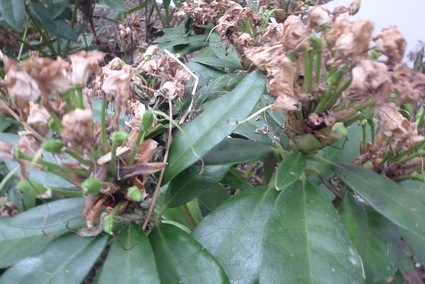
The sad outcome of the experiment was not planned but it certainly provides us with a lesson. This indoor garden explores alienation, men’s relentless interference with nature. However, as the catalogue of the exhibition states, “EXOTE’s aim is not to position itself within the scientific debate on biological invasions, but to be a metaphor to reflect on our interaction with the environment in which we live.”
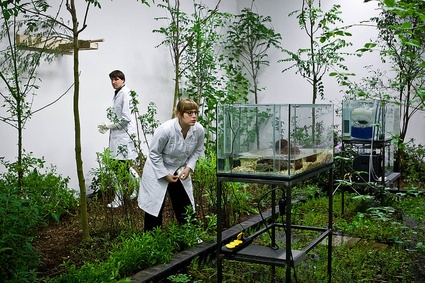 Kris Verdonck, EXOTE, 2011. Produced for the exhibition Kris Verdonck – EXHIBITION at #1. Photo: Kristof Vrancken / Z33
Kris Verdonck, EXOTE, 2011. Produced for the exhibition Kris Verdonck – EXHIBITION at #1. Photo: Kristof Vrancken / Z33
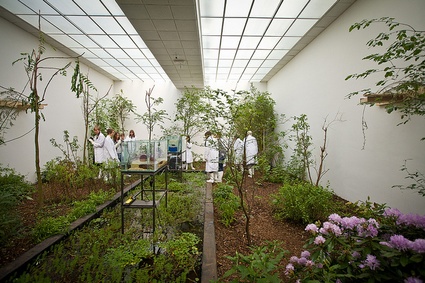 Kris Verdonck, EXOTE, 2011. Produced for the exhibition Kris Verdonck – EXHIBITION at #1. Photo: Kristof Vrancken / Z33
Kris Verdonck, EXOTE, 2011. Produced for the exhibition Kris Verdonck – EXHIBITION at #1. Photo: Kristof Vrancken / Z33
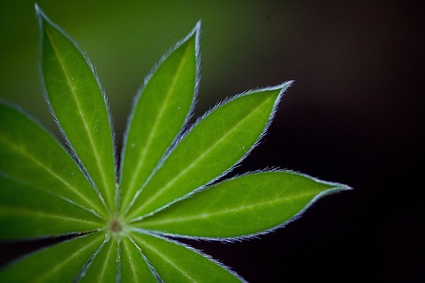 Kris Verdonck, EXOTE, 2011. Produced for the exhibition Kris Verdonck – EXHIBITION at #1. Photo: Kristof Vrancken / Z33
Kris Verdonck, EXOTE, 2011. Produced for the exhibition Kris Verdonck – EXHIBITION at #1. Photo: Kristof Vrancken / Z33
EXOTE is part of the exhibition Kris Verdonck – EXIBITION #1, on view at Z33 House for Contemporary Art until August 21, 2011.
